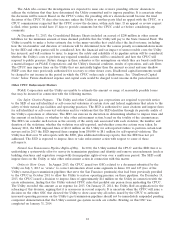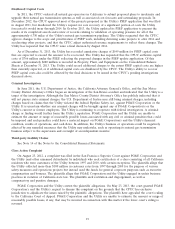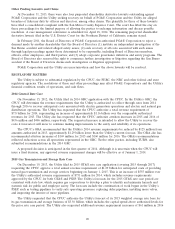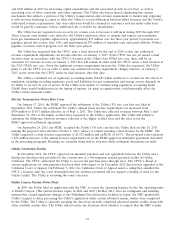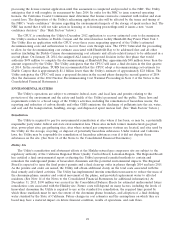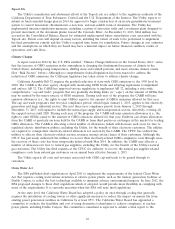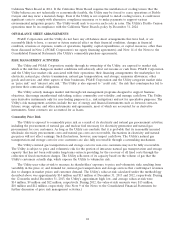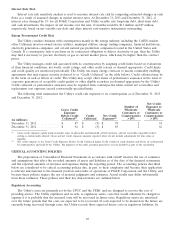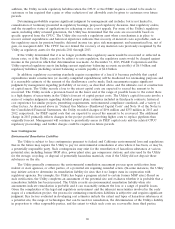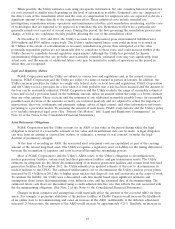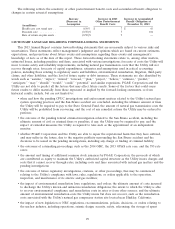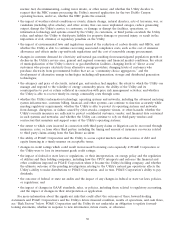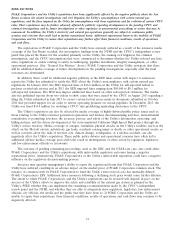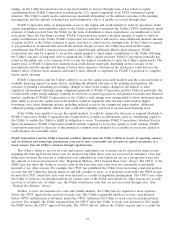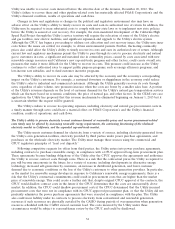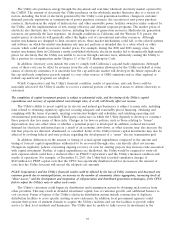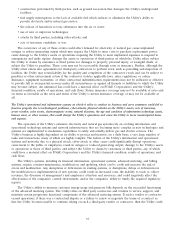PG&E 2013 Annual Report Download - page 34
Download and view the complete annual report
Please find page 34 of the 2013 PG&E annual report below. You can navigate through the pages in the report by either clicking on the pages listed below, or by using the keyword search tool below to find specific information within the annual report.
the discount rate by 25 basis points would decrease the amount of the ARO by 5.24%. At December 31, 2013, the
Utility’s recorded ARO for the estimated cost of retiring these long-lived assets was $3.5 billion.
Pension and Other Postretirement Benefit Plans
PG&E Corporation and the Utility provide a non-contributory defined benefit pension plan for eligible
employees as well as contributory postretirement health care and medical plans for eligible retirees and their eligible
dependents, and non-contributory postretirement life insurance plans for eligible employees and retirees.
The pension and other postretirement benefit obligations are calculated using actuarial models as of the
December 31 measurement date. The significant actuarial assumptions used in determining pension and other benefit
obligations include the discount rate, the average rate of future compensation increases, the health care cost trend
rate and the expected return on plan assets. PG&E Corporation and the Utility review these assumptions on an
annual basis and adjust them as necessary. While PG&E Corporation and the Utility believe that the assumptions
used are appropriate, significant differences in actual experience, plan changes or amendments, or significant changes
in assumptions may materially affect the recorded pension and other postretirement benefit obligations and future
plan expenses.
PG&E Corporation and the Utility recognize the funded status of their respective plans on their respective
Consolidated Balance Sheets with an offsetting entry to accumulated other comprehensive income (loss); or, to the
extent that the cost of the plans are recoverable in utility rates, to regulatory assets and liabilities, resulting in no
impact to their respective Consolidated Statements of Income.
Pension and other benefit expense is based on the differences between actuarial assumptions and actual plan
results and is deferred in accumulated other comprehensive income (loss) and amortized into income on a gradual
basis. The differences between pension benefit expense recognized in accordance with GAAP and amounts
recognized for ratemaking purposes are recorded as regulatory assets or liabilities as amounts are probable of
recovery from customers. To the extent the other benefits are in an overfunded position, the Utility records a
regulatory liability for a portion of the credit balance in accumulated other comprehensive income. (See Note 3 of
the Notes to the Consolidated Financial Statements.)
PG&E Corporation and the Utility review recent cost trends and projected future trends in establishing health
care cost trend rates. This evaluation suggests that current rates of inflation are expected to continue in the near
term. In recognition of continued high inflation in health care costs and given the design of PG&E Corporation’s
plans, the assumed health care cost trend rate for 2013 is 8%, gradually decreasing to the ultimate trend rate of 5%
in 2020 and beyond.
Expected rates of return on plan assets were developed by determining projected stock and bond returns and
then applying these returns to the target asset allocations of the employee benefit trusts, resulting in a weighted
average rate of return on plan assets. Fixed-income returns were projected based on real maturity and credit spreads
added to a long-term inflation rate. Equity returns were estimated based on estimates of dividend yield and real
earnings growth added to a long-term rate of inflation. For the Utility’s defined benefit pension plan, the assumed
return of 6.5% compares to a ten-year actual return of 8.7%.
The rate used to discount pension benefits and other benefits was based on a yield curve developed from market
data of approximately 494 Aa-grade non-callable bonds at December 31, 2013. This yield curve has discount rates
that vary based on the duration of the obligations. The estimated future cash flows for the pension and other
postretirement benefit obligations were matched to the corresponding rates on the yield curve to derive a weighted
average discount rate.
The following reflects the sensitivity of pension costs and projected benefit obligation to changes in certain
actuarial assumptions:
Increase (Decrease) Increase in 2013 Increase in Projected
in Pension Benefit Obligation at
Assumption Costs December 31, 2013
(in millions)
Discount rate ................ (0.50)% $ 122 $ 1,041
Rate of return on plan assets ..... (0.50)% 60 —
Rate of increase in compensation . . 0.50% 60 246
28


